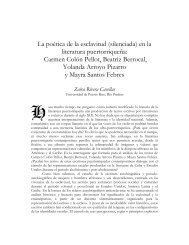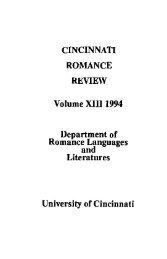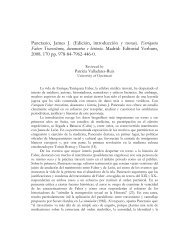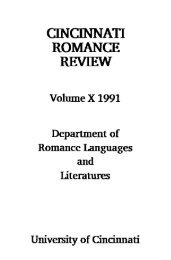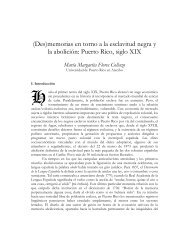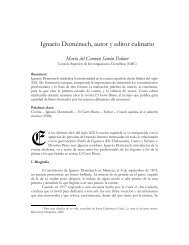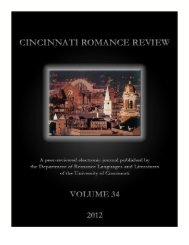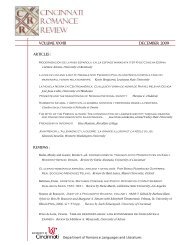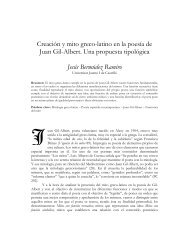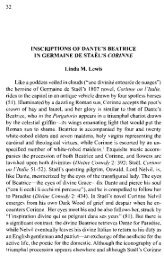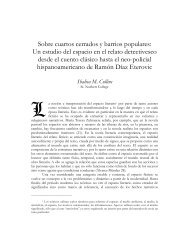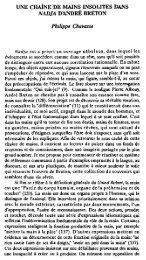Volume 30 (2011) - Cincinnati Romance Review
Volume 30 (2011) - Cincinnati Romance Review
Volume 30 (2011) - Cincinnati Romance Review
Create successful ePaper yourself
Turn your PDF publications into a flip-book with our unique Google optimized e-Paper software.
180<br />
GALADRIEL MEHERA GERARDO<br />
them unworthy of mention in his vision of a new fatherland. On the one hand he may<br />
not have seen them as a problem equally deserving of attention to indigenous people,<br />
possibly because of their significantly smaller number. On the other hand his refusal to<br />
address people of African descent suggests that he did not consider them sufficiently<br />
positive a force to factor into his image of the new Mexican fatherland. Because of his<br />
considerable stay in the United States as an adult in graduate school, Gamio, more so<br />
than Vasconcelos, was likely influenced by the U.S. positioning of African Americans at<br />
the bottom of the racial hierarchy. Even his “liberal” Boasian education would have<br />
done little to dissuade this attitude. Boas, Ruth Benedict, and other Columbia<br />
anthropologists of their generation concentrated on racial “others” abroad and<br />
occasionally on those they viewed as primitives in their midst (such as Native<br />
Americans), but paid little heed to the plight of African Americans. Whatever the exact<br />
reason, Gamio’s choice to exclude Africans from his discussion of the future of the<br />
Mexican nation underlines the perseverance of U.S. influence on Mexican racial thought<br />
in the revolutionary period.<br />
Octavio Paz emerged as the voice of Mexico a generation after Gamio and<br />
Vasconcelos. He first experienced the United States in 1943 when he visited on a<br />
Guggenheim Fellowship. While firmly committed to literature throughout his life, he<br />
regularly held posts in the Mexican government, first as a diplomat to France in 1945,<br />
where he wrote his most famous work, El Laberinto de la Soledad (The Labyrinth of<br />
Solitude), which first appeared in print in 1950. In 1962 Mexico made him ambassador to<br />
India, but he resigned from government service in 1968 in reaction to the Tlateloco<br />
massacre. 6 As not only a post-revolutionary but also a post-WWII scholar, Paz, more so<br />
than Gamio and Vasconcelos, distanced himself from pseudo-scientific discussions of<br />
race. Social scientists and policy makers of Paz’s generation often used “ethnicity” as<br />
opposed to “race” and attempted to move away from explicitly discussing racial issues,<br />
but the ideas about race underlying their arguments changed little from those of the<br />
previous generation (Appelbaum 8).<br />
Although he later claimed, “The Labyrinth of Solitude was…something very<br />
different from an essay on Mexican-ness or a search for our supposed being” (Paz 215),<br />
it nonetheless came to be regarded as the definitive work on the Mexican character,<br />
both internationally and in Mexico. Much of what he wrote had little to do with race on<br />
the surface, and he even stated that what determines a Mexican is not race but rather<br />
mentality. Nonetheless, in discussing the historical factors that contributed to the<br />
Mexican condition, Paz emphasized the European and indigenous background while<br />
virtually ignoring African heritage. While noticeably more critical of the European<br />
influence (both racial and intellectual) than Vasconcelos and Gamio, Paz’s vision for a<br />
Mexican who had more in common with humankind in general demonstrates Euro-<br />
American influence.<br />
6 For more on Paz, see Silvia Nora Rosman (2003) and James W. Wilkie (1981).<br />
<strong>Cincinnati</strong> <strong>Romance</strong> <strong>Review</strong> <strong>30</strong> (Winter <strong>2011</strong>): 172-183.



